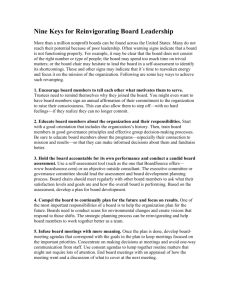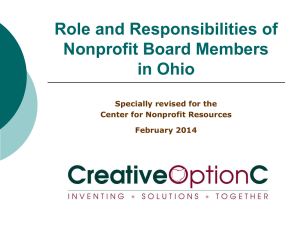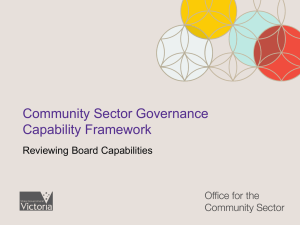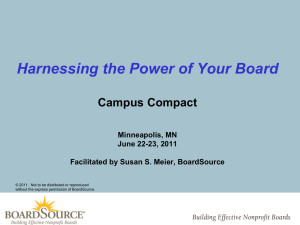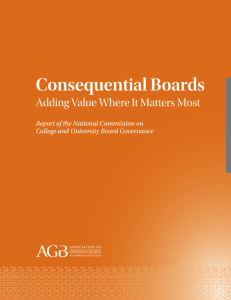Board Self Assessment and Calendar
advertisement
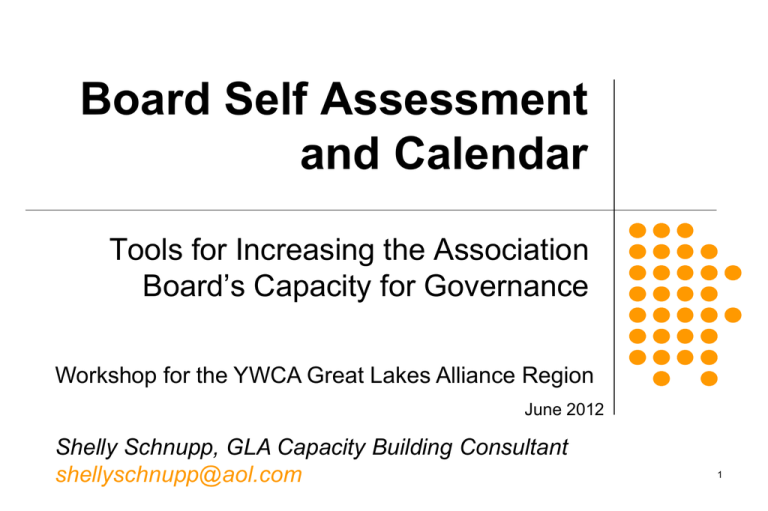
Board Self Assessment and Calendar Tools for Increasing the Association Board’s Capacity for Governance Workshop for the YWCA Great Lakes Alliance Region June 2012 Shelly Schnupp, GLA Capacity Building Consultant shellyschnupp@aol.com 1 Topics to be Covered Why Board Self Assessment Benefits and Challenges of Self Assessment Some Approaches and Resources Board Calendar 2 Boards are ultimately responsible for their organization, yet they spend little time examining their performance. BoardSource 3 …there are likely to be improvements in both board and organizational effectiveness when efforts are undertaken to improve how boards do their work.” Robert D. Herman and David O. Renz, 2000 4 Governance Challenges Confusion Disinterest Dissatisfaction 5 Governance Challenges Confusion Clarity Disinterest Engagement Dissatisfaction Satisfaction 6 Board Calendar • • • • Clarify aspects of board’s responsibilities Legal, financial and other obligations Objective tool for keeping board on track Informs the agenda for meetings 7 Board Calendar Items • • • • • • 990 Filing Audit Budget approval Strategic plan review Conflict of interest review Bylaws and Policies review • • • • YWCA Peer Review, other important responsibilities Fundraising registration Chief Executive performance evaluation Board self assessment 8 Why Board Self Assessment? Board Self Awareness Strengthen board performance Improve organizational effectiveness 9 …those practices that are used more frequently by the especially effective boards include (a) board self-evaluation…. Robert D. Herman and David O. Renz, 2000 10 Role of Board Self Assessment Diagnostic Educational Engagement 11 Self Assessment Areas: (Mix of Compliance and Performance) Composition and structure Compliance with policies and laws Quality of functioning Governance contribution 12 More Specifically…………. • • • • • • • • • • Setting and keeping the focus on the mission Charting a clear strategic direction and assessing progress Monitoring the organization’s services and programs Providing financial oversight Actively engaging in resource development Communication and community relations Supporting and evaluating the executive director Providing appropriate support to the staff Demonstrating best practices in board governance Strategically selecting, recruiting and orienting new board members 13 Benefits of Board Self Assessment Increase the board’s understanding of it’s purpose, roles, responsibilities Eliminate misunderstanding Promote accountability Identify areas that need attention Establish board values and set standards Improve board recruitment Encourage board “self-selection” 14 Self Assessment Approaches Existing data (attendance, achievement of goals, etc.) Board Member opinion Opinions of others Full board and individual members Online tools 15 Typical Self Assessment Tools Simple checklist Comprehensive survey Interviews Open-ended questions 16 Factors that typically affect use or absence of approaches and tools Time Interest Culture Crisis Experience What should drive use of approaches or tools? Expectations and beliefs about boards/ governance 17 Governance as Leadership Richard P. Chait William P. Ryan Barbara E. Taylor 2005 18 Governance as Leadership Type I Fiduciary: Board as Control Mechanism Type II Strategic: Board as Direction-Setter Type III: Generative Board as Meaning-Maker 19 Type I Governance: Fiduciary Work Board as steward, monitor. Are we meeting our mission legally, efficiently and effectively? What’s wrong? Type II Governance: Strategic Work Board as strategic partner. What are the most effective ways to achieve our goals? What’s the plan? Prevent theft, waste, misuse of Develop consensus about resources. Hold management organizational strategy. accountable. Compliance. Engage in strategic thinking. Clarify organizational goals and •Ensure plan is developed and strategy for getting there. oversee implementation. •Receive and review annual Problem solving and strategy audit. Ensure balanced budget. development. •Ensure program effectiveness. Type III Governance: Generative Work Board as collaborative leader. What does our mission mean? What’s the question? Frame –and re-frame— problems that drive the organization’s work— ”possibilities and pathways.” Engage in “sense-making.” Discover new opportunities, generate new ideas. Values-based deliberation. 20 Governance as Leadership Type I Fiduciary: Board as Control Mechanism Type II Strategic: Board as Direction-Setter Type III: Generative Board as Meaning-Maker Effective boards move deftly between Types I, II and III work. 21 Critical View of Board Self Assessment Tools To what extent does the tool expect or encourage the three modes of governance outlined in Governance as Leadership? Type I: Fiduciary Type II: Strategic Type III: Generative 22 Board Self Assessment Tips • • • • • • • Put it on the Board Calendar! Frequency—every two years? Consider multiple approaches Views and expectations of the board should drive self-assessment approaches and tools. Many tools available – be critical Encourage candor Don’t forget to use the results 23 The Role of Board Self Assessment • • Boards/Governance affects nonprofit effectiveness Self-assessment is one tool that can improve governance…and possibly nonprofit effectiveness 24 Challenges of Board Self Assessment • • • Oversimplification of complexity Instill false sense of security Encourage certain modes of governance—discourage others 25 Although evidence supporting the relationship between board effectiveness and organizational effectiveness is increasing, in what ways and how boards contribute to organizational effectiveness is still unclear. Robert D. Herman and David O. Renz, BOARD PRACTICES OF ESPECIALLY EFFECTIVE AND LESS EFFECTIVE LOCAL NONPROFIT ORGANIZATIONS, The American Review of Public Administration 2000 30: 146 26 Additional Sources of Information Self-Assessment for Nonprofit Governing Boards by Larry H. Slesinger. National Center for Nonprofit Boards, 1996. Includes forms for board assessing the functioning of the board as a whole and a form for indiviudal board member self reflection. Board of Directors Self Evaluation by Carter MacNamara. 14 question tool that boards can use to rate the performance of the full board. The Best of Board Café by Jan Masoka. Compasspoint Nonprofit Services, 2003. A comprehensive collection of short but informative articles on many aspects of nonprofit board functioning and development. 27 Additional Sources of Information • National Council of Nonprofits http://www.councilofnonprofits.org/resources/resour ces-topic/boards-governance/board-member-selfassessment • BoardSource 28
